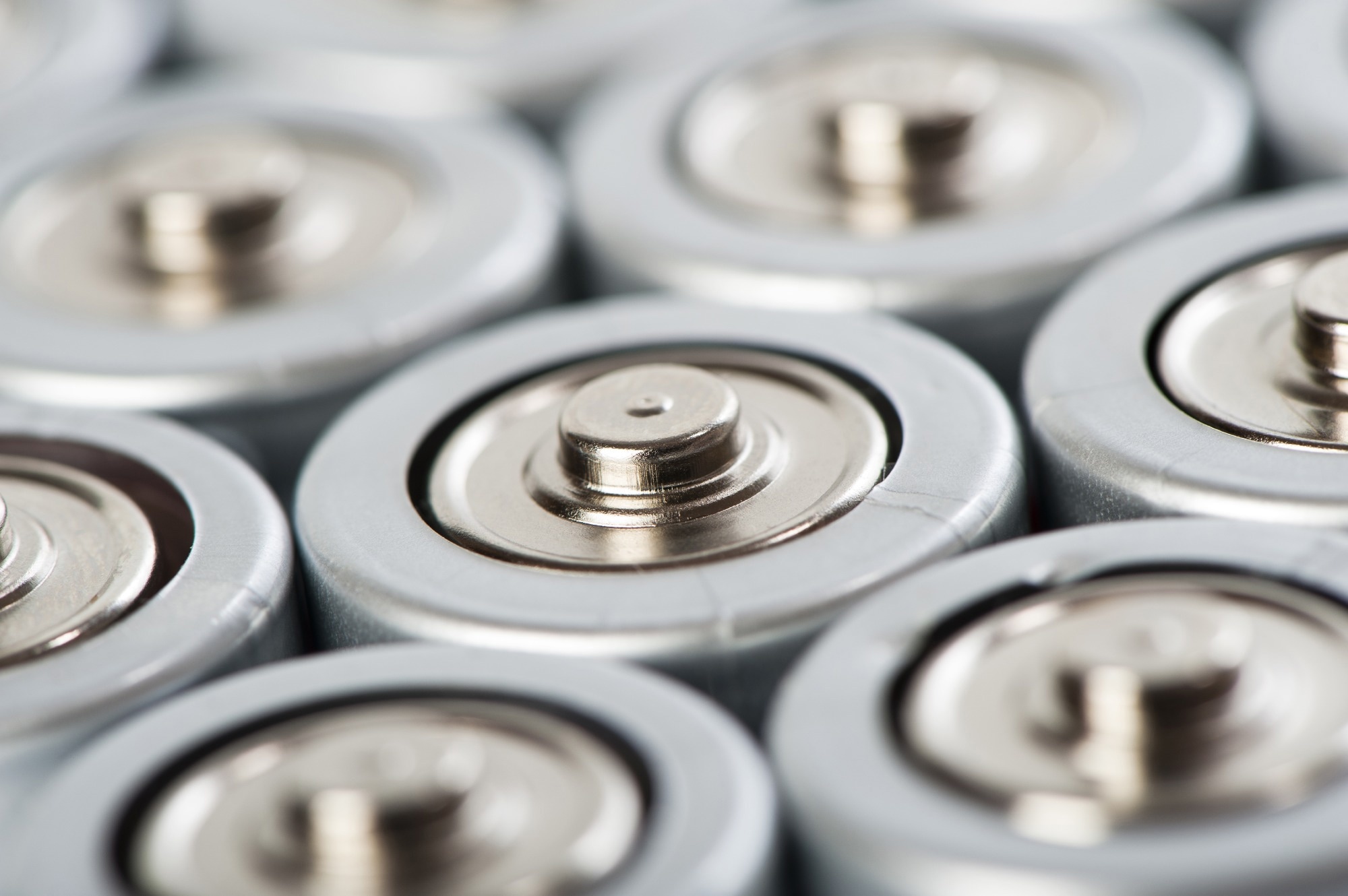A recent article published in Energy Storage Materials introduced the synthesis of p-type radical polymer cathodes for aqueous zinc-ion batteries (AZIBs) using a low-cost industrial poly(methyl vinyl ether-alt-maleic anhydride) (poly(MVE-alt-MA)) polymer.

Image Credit: art nick/Shutterstock.com
Background
AZIBs have emerged as sustainable energy storage solutions due to zinc's abundance, low cost, safety, and low toxicity. While stable zinc anodes have been developed, finding high-performing cathodes remains a significant challenge.
Inorganic cathodes comprising Mn and V exhibit ambiguous charge storage mechanisms, leading to poor energy efficiency and power performance. Organic cathodes demonstrate a much higher charge/discharge rate. However, most organic cathodes are n-type polyaromatic compounds or conjugated polymers. These require sophisticated synthesis, provide a low operational voltage, and slow Zn2+ diffusion kinetics.
Non-conjugated redox-active polymers (RAPs) are well-adaptable organic cathodes for energy storage. Among these, nitroxide radical polymers (NRPs), which primarily consist of pendant TEMPO (2,2,6,6-tetramethylpiperidiyl-1-oxyl) radicals, show a relatively high redox potential and excellent reversibility in both organic and aqueous media, making them ideal candidates for AZIB cathodes to achieve high output voltage.
Methods
Two synthesis pathways were explored to create NRP cathodes. The first involved directly modifying poly(MVE-alt-MA) with NH2-TEMPO to obtain PTEMPO. The other approach involved synthesizing 2,2,6,6-tetramethylpiperidine (TEMP) functional polymers (PTEMP) through the modification of poly(MVE-alt-MA) with triacetonediamine and then oxidizing them to form PTEMPO.
The synthesized NRPs were characterized using nuclear magnetic resonance (NMR), Fourier-transform infrared (FTIR), and electron paramagnetic (EPR) spectroscopic methods to examine their structures and radical content before testing in AZIBs. In addition, cyclic voltammetry, chronoamperometry, and electrochemical impedance spectrometry measurements were recorded on a potentiostat to analyze their electrochemical behavior.
Various carbon additives and electrolyte compositions were tested to optimize battery performance at a minimal cost.
Firstly, cathodes for Swagelok cells were prepared by blending PTEMPO with carbon additives (multi-walled carbon nanotubes (MWCNTs)) without using any binder. The prepared slurry was coated on pre-weighted carbon felts (diameter 1 cm, thickness 2 mm) for Swagelok cells. Alternatively, 2.5x3.5 cm2 carbon felts were coated with PTEMPO-5/MWCNTs composite slurry for small pouch batteries.
BP2000 carbon-based slurry was prepared for large pouch cells and coated on pre-weighted carbon felts (4x4.5 cm2). Battery tests were conducted on a standardized system across all configurations. To showcase the ease and efficiency of fabricating NRP-based AZIBs, multiple large pouch batteries were assembled.
Results and Discussion
NRPs with six different molecular weights were successfully synthesized using both approaches, with PTEMPO-1 and PTEMPO-2 exhibiting higher molecular weights. The NMR spectra of PTEMPO and PTEMP exhibited new peaks at 4.1 ppm and 1.2-1.5 ppm, respectively, compared to poly(MVE-alt-MA). These peaks corresponded to methyl and methine protons from the piperidine ring.
The reaction efficiency was estimated at 65 % by NMR, assuming two radicals per anhydride as 100 %, and this was further validated by EPR spectra. The EPR spectra of PTEMPO polymers showed broad signals, indicating radical-radical coupling along the polymer chain.
Low-molecular-weight PTEMPO yielded higher modification efficiencies and theoretical capacities. For example, two reactions conducted at a three-gram scale produced PTEMPO-3 and PTEMPO-4, both with low molecular weights and similar theoretical capacities.
The scaled-up reaction (PTEMPO-5) lowered the efficiency and capacity. Alternatively, PTEMPO-2 and PTEMPO-6, obtained from the second approach, exhibited relatively low capacities due to the generally low efficiency of two-step reactions (conjugation and oxidation). Also, these delivered lower discharge capacities than their theoretical values.
Polymers synthesized using the first approach delivered discharge capacities that closely matched their theoretical values in battery systems. Notably, the Swagelok battery, which used PTEMPO-3 combined with an equal amount of MWCNTs in 2 M Zn(OTf)2, achieved high discharge capacity, excellent rate performance, and long-term cycling stability at a high rate. Moreover, increasing mass loading did not diminish its capacity or cycling performance, making the first approach more effective for achieving higher radical content with fewer synthesis steps.
Nevertheless, all large pouch batteries using PTEMPO/BP-2000 composite cathodes maintained good charge and discharge plateaus with reproducible performance. In addition, the excellent performance of the synthesized NRPs in small pouch batteries is promising for low-power applications such as an electric fan.
Conclusion
The researchers successfully modified commercial poly(MVE-alt-MA) with 4-amino-TEMPO radical via two approaches to produce NRPs. These polymers with amide, methoxy, and carboxylic acid functionalities exhibited good hydrophilicity but insolubility in aqueous electrolytes, ideal as organic cathodes for AZIBs.
A Swagelok AZIB with 50 % active material (PTEMPO) and 50 % MWCNT delivered a high discharge capacity, retaining 93 % of its highest capacity and 99.93 % Coulombic efficiency after 1000 cycles. Moreover, a non-expensive pouch battery made using scaled-up PTEMPO polymer and BP2000 carbon black performed well.
As per the researchers’ cost analysis, the prepared PTEMPO was much cheaper than other reported polymer electrodes and delivered higher voltage outputs than the cheaper electrodes. Thus, the proposed NRP cathodes for AZIBs are promising for real-world applications.
More from AZoM: Optimizing Control Strategies for the Manufacture of Lithium-Ion Electrodes
Journal Reference
Gamage, NSW., et al. (2024). Converting a low-cost industrial polymer into organic cathodes for high mass-loading aqueous zinc-Ion batteries. Energy Storage Materials. DOI: 10.1016/j.ensm.2024.103731, https://www.sciencedirect.com/science/article/pii/S2405829724005579
Disclaimer: The views expressed here are those of the author expressed in their private capacity and do not necessarily represent the views of AZoM.com Limited T/A AZoNetwork the owner and operator of this website. This disclaimer forms part of the Terms and conditions of use of this website.